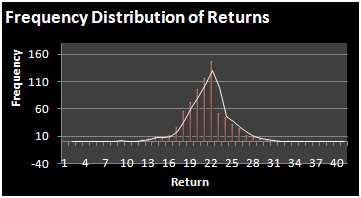How to measure Alpha when allocating capital to a basket of stocks in a position based trading portfolio.
From a probabilistic perspective it is useful when constructing portfolio return models to measure the strength of the returns we are observing. This is why a simple frequency distribution model helps. When the hedge fund manager selects a basket of stocks and wishes to allocate capital based on expected returns, it is advisable to measure the strength of those expected returns.
If we observe a weak correlation of returns in the price data it is a good guide to how much faith we should place on the model recommendation. The process of stock picking is part art and part science. For example a money manager can choose to place a proportion of the available capital to work at any one time and put a proportion on reserve.
We often hear about managers using a policy approach, that is some derivative of the 80 20 rule or Pareto principle.. I have nothing against this but it is very generalistic. I prefer the quantitative approach which at least gives us a variable number to work with.
On some days the correlation is strong so the total capital allocation is greater, and on other trading days the correlation is weak, so the allocation is reduced. This provides the hedge fund manager with the flexibility to deviate from policy in a calculated intelligent way. This is the purpose of Data Visualisation and Market Intelligence, keeping to rigid policy will break the success of the trader.
The well informed trader will be smart enough to place reliance on the signals his or her model is throwing out and have the confidence to execute trades. It is to a degree playing the odds, and hedging your bets.
The so called coefficient of correlation or measure of strength in the observation can be used to make the decision, all in or hold back.
Not to make it too academic, the manager simply must use a blend of judgement and math to determine precisely how much of the capital should be put at risk at any point in time or in any one trading position. This model therefore helps the manager avoid the fear or indecision problem. If the correlation is strong, the buy signal can be tempered with this insight.
The strength of the correlation changes from day to day of course and so should be used as a short term decision making tool.
In my hedge fund I would use the model on each trade, but confirm this with my broader view on the macro economy.